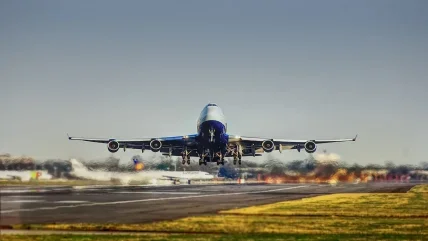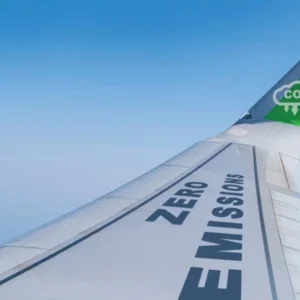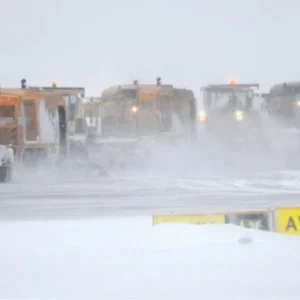
It is a widely known fact that the most dangerous stage of a flight is actually down on the ground – during take-off and landing – rather than in the air. According to the International Air Traffic Association’s (IATA) 2021 safety report, of the 221 accidents that happened between 2017 and 2021, 24% of those were during take-off proceedings alone. This stage of the flight also accounted for 11 of the 37 fatal aircraft accidents. So, being such a crucial moment – and an opportune stage where crafts are grounded and detailed checks can be made – strict protocols for preparing aircraft for their journey are vital.
A common ingredient in aircraft accidents is adverse weather – everything from obfuscating fog or debilitating ice. Some may remember reports of the Air Florida Flight 90 crash of 1982, where – after managing only 30 seconds in the air – the aircraft crashed into the 14th Street bridge connecting Arlington, Virginia to Washington DC, with everything but its tail plunging into the Potomac River. Only five of the 79 occupants survived, with four motorists on the bridge also succumbing to fatal injuries.
A National Transportation Safety Board (NTSB) investigation determined that the probable cause of the crash was a combination of pilot error and a “prolonged delay between de-icing and the receipt of ATC takeoff”. The report also mentioned “little communication between Air Florida and American Airlines” about de-icing procedures. De-icing is the process in which an aircraft is sprayed down with a concoction that melts ice that has collected on its wings. Anti-icing is applied afterwards, helping to keep the wings free from frost during its ascent into the skies.
Fast forward to the modern day and a situation similar to that of the Air Florida flight would not be allowed to occur due to the greater level of scrutiny that de-icing procedures are carried out under. This is, in part, is thanks to the work of the IATA De-Icing/ Anti-Icing Quality Control Pool, or DAQCP for short. Consisting of over 100 member airlines, the pool shares audits of de-icing and anti-icing services across the globe, as well as collating helpful information on procedures and protocol. The DAQCP celebrates its 25th anniversary this year.
From thin ice to sturdy ground
When it comes to the DAQCP, there aren’t better people to speak to than Dimitri Rybkin and Jessica Dawe. Rybkin is the manager of quality alliances & suppliers for Etihad Airways, and has served as the chairman of the DAQCP since July 2021, while Dawe, manager, charter of professional auditors at the IATA, has been running the DAQCP for the past ten years. Lately, the two have been in constant communication with each other because, as Dawe describes, “the workload of the pool has become a bit more intense”.
In 1997, eight European airlines – Swissair, Sabena, Air France, KLM, Lufthansa, SAS, Finnair and Austrian Airlines – sought to establish lines of communication on anti-icing and de-icing service providers. “The pool started with the intention of saving costs and sharing the workloads of audits that the eight airlines were performing,” explains Dawe. “[The airlines] realised that they were going to the same airports, with the same providers, but they were all auditing separately. It made more sense to pull together.” And so, the DAQCP was born.
A quarter of a century on and things have grown exponentially. Now boasting 139 member airlines, the DAQCP dedicates itself to the continuous improvement of its own organisation, of the standards it upholds and the service providers that it surveys. With such a large pool, the pair are confident of the organisation’s reputation. For example, since a global standard on de-icing was issued back in 2016, the DAQCP has been one of the main bodies championing it and ensuring it is adhered to across the globe.
Its relationship with IATA has evolved too. At its beginning, the DAQCP needed IATA’s administrative support after growing past its original eight airlines. Today, the two work as a partnership on certain objectives, with the pool helping to “keep [IATA’s] operational knowledge fresh”, as Dawe puts it.
“The DAQCP has a very strong voice, which it uses to speak to service providers all over the world,” Rybkin adds. He goes on to highlight the DAQCP’s main priority and guiding objective: “Our mission is always to make things safer.”
Standard procedure
The DAQCP breeds uniformity in operations for service providers. This makes things safer and more cost-effective for airlines, as well as saving time. “Training becomes easier, work becomes safer and more efficient as employees do not have to trouble themselves with differing protocols,” Dawe says, adding that this can free up time and resources to allow for the improvement of aspects such as customer service.
For instance, take what are known in the industry as ‘alternate airports’. As Rybkin says, “It doesn’t matter how good you plan, there is always space for unforeseen circumstances”. This is why every airline has a list of airports lined up as alternative choices when it comes to taking off, landing or if an aircraft is forced to take an alternative route. This results in a huge number of airports and service providers that need to be vetted, with airlines needing assurances that they will be able to depend on credible anti-icing and de-icing protocols wherever they end up.
This is exactly the situation in which the DAQCP is effective. “We can provide assurances that, if an aircraft diverts in winter, it will be properly inspected and treated by qualified people and that it will safely depart,” Rybkin explains. “In a standardised world, we can plan in short-term, medium-term and long-term. This is essential for airlines – to be able to know that they will be able to depend on the same equipment, standards, processes and anything else into the next winter season and three winter seasons after that.”
Widen the wingspan
One of the main reasons for the uptick in Dawe and Rybkin’s workload is due to the news that four North American airlines will be joining the pool. This means that the DAQCP will have to do over 40 evaluations this winter, due to the new auditors. It’s a daunting challenge. Fortunately, a technical training group that Rybkin says represents the “best of the best” of the pool will be ready to jump into action around that time.
Far from seeing the inclusion of these four new airlines as a challenge, Dawe and Rybkin express excitement surrounding their inclusion. “We will be able to compare knowledge and look at how different organisations approach providers and problems,” Dawe says. The pool has a certain ripple effect, in that every airline that joins is a victory in and of itself. At the same time, the validation that each new member brings also bolsters the reputation of the existing members and the pool as a whole.
This aspect of validation is very important to the DAQCP as it makes its first forays into not only North America, but also looks to strengthen its reputation in Asia as well. Dawe explains that their membership does include some Japanese airlines and plans to expand those numbers were being formulated but were later shelved due to the Covid- 19 pandemic. However, there is an eagerness to get back to this process back on track. “Now that the situation is normalising, we will be looking into that again as well,” she adds.
De-ice, reuse, repeat
However, the DAQCP team isn’t solely focused on expanding the pool’s global reach – sustainability is also becoming a key objective. While it must be said that, in the grand scheme of things, de-icing and anti-icing’s carbon emissions are a drop in the ocean compared with that of other aspects of air travel, Rybkin takes a stalwart attitude. “Does this mean we should just disregard what we can do? No. Every drop counts,” he notes. “It is about establishing a mindset that leans towards reuse and cost-effectiveness.”
The DAQCP’s accumulated knowledge enables it to point airlines towards the most sustainable options when it comes to service providers, with some having better protocols around reusing excess de-icing and anti-icing fluid than others. Using its collective voice, the pool can also advocate for these more sustainable processes to be adopted across the globe.
Once again, Rybkin takes an aspirational tone when speaking on what the DAQCP could be in the years to come. In particular, he draws attention to the need for a driving force to champion innovations created by start-ups and organisations that could lead the way to much more sustainable de-icing and anti-icing processes. “There is a need there and a real sense that the DAQCP can provide that advocacy,” he says.
Now established as a means of assuring service providers are regulated and their processes are standardised – with plans to expand to new locations – the DAQCP is, in many ways, emboldening the spirit of communication that was fostered all that time ago, albeit with the infrastructure to serve its ever-increasing membership. As Rybkin puts it: “It is a platform where 139 airlines can get together and talk. We get together in person at our general meetings. We share experience and knowledge, and learn together. We talk about problems, of course, but we talk about solutions too.” It is this spirit of communication and collaboration that is the true heart of the DAQCP, and will carry it through another quarter of a century and beyond.
1982
Air Florida Flight 90 crash occurs, due to a combination of pilot error and a prolonged delay between de-icing and take-off.
1997
DAQCP is founded.
2006
DAQCP starts working in partnership with IATA.
2011
IATA begins spearheading a project with the aim of developing global de-icing standards.
2016
Global standard on de-icing is issued, championed by the DAQCP.
2022
DAQCP celebrates its 25th anniversary.
8
The number of European Airlines that made up DAQCP’s original membership: Swissair, Sabena, Air France, KLM, Lufthansa, SAS, Finnair and Austrian Airlines.
139
The number of member airlines in the DAQCP in 2022.
DAQCP






